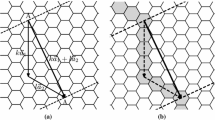Abstract
A single heptagon together with a single pentagon can join two graphene semitubules together at a 30° angle so that all carbon atoms are three-fold coordinated and all other carbon rings are hexagons. This bend connects tubules of complementary classes. A tubule class is the set of all tubules having the same helicity. A tubule class has a uniform density of radii, which is the number of different tubules in the class per unit change in tubule radius. The classes that are joined by a heptagon and pentagon have smallest members whose radii differ by a factor of √3. Thus tubule segments joined by a heptagon and pentagon cannot have exactly equal circumferences. There are only a finite number of twist angles allowed between sequential bends along a tubule. Pentagons and heptagons should be isolated and separated as far as possible. These requirements particularly constrain the bends and twists that can occur in the smallest tubules. These considerations favor long-range order along a helix, given a driving force for curling during the formation process.
Similar content being viewed by others
References
H.W. Kroto, J.R. Heath, S.C. O’Brien, R.F. Curl and R.E. Smalley
W. Krätschmer, L.D. Lamb, K. Fostiropoulos, and D.R. Huffman, Nature 347, 354 (1990).
H.W. Kroto, Nature 329, 529 (1987).
S. Iijima, Nature (London) 354, 56 (1991).
M.S. Dresselhaus, G. Dresselhaus, and R. Saito, Phys. Rev. B 45, 6234 (1992).
J.W. Mintmire, B.I. Dunlap, and C.T. White, Phys. Rev. Lett. 68, 631 (1992).
C.T. White, D.H. Robertson, and J.W. Mintmire, Phys. Rev. B 47, 5485 (1993).
B.I. Dunlap, Phys. Rev. B 46, 1933 (1992).
S. Iijima, RM. Ajayan, and T. Ichihashi, Phys. Rev. Lett. 69, 3100 (1992).
B.I. Dunlap, Phys. Rev. B 49, 5643 (1994).
B.I. Dunlap, Phys. Rev. B 50, 8134 (1994).
X.B. Zhang, Z.F. Zhang, D. Bernaerts, G. Van Tendeloo, S. Amelinckx, J. Van Lan-druyt, V. Ivanov, J.B. Nagy, Ph. Lambin, and A.A. Lucas, Europhys. Lett. 27, 141 (1994).
S. Amelinckx, X.B. Zhang, D. Bernaerts, X.F. Zhang, V. Ivanov, J.B. Nagy, Science 265, 635 (1994).
D.H. Robertson, D.W. Brenner, and J.W. Mintmire, Phys. Rev. B 45, 12592 (1992).
M. Fujita, R. Saito, G. Dresselhaus, and M.S. Dresselhaus, Phys. Rev. B, 45, 12834 (1992).
Author information
Authors and Affiliations
Rights and permissions
About this article
Cite this article
Dunlap, B.I. Constraints on Small Fullerene Helices. MRS Online Proceedings Library 359, 169–174 (1994). https://doi.org/10.1557/PROC-359-169
Published:
Issue Date:
DOI: https://doi.org/10.1557/PROC-359-169




